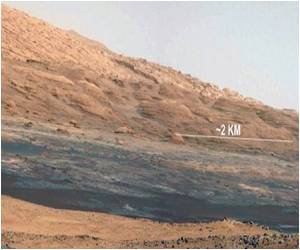Researchers have confirmed the presence of small amounts of water on the Red Planet contained in the dust and fine soil.

Researchers believed the hydrogen seen in the dust was coming from water, a hypothesis that was later corroborated by Curiosity's SAM instrument, which indicated that all of the soil encountered on Mars contains between 1.5 and 3 percent water.
This quantity is enough to explain much of the near-equatorial hydrogen observed beginning in 2001 by Los Alamos' neutron spectrometer on board the Mars Odyssey spacecraft.
ChemCam also showed that the soils consist of two distinct components. In addition to extremely fine-grained particles that seem to be representative of the ubiquitous Martian dust covering the entire planet's surface like the fine film that collects on the undisturbed surfaces of a long-abandoned home, the ChemCam team discovered coarser-grained particles up to one millimeter in size that reflected the composition of local rocks.
In essence, ChemCam observed the process of rocks being ground down to soil over time.
The ChemCam instrument - which vaporizes material with a high-powered laser and reads the resultant plasma with a spectrometer - has shown a similar composition to fine-grained dust characterized on other parts of the planet during previous Martian missions.
Advertisement
What's more, the Rover dug into the soils at Rocknest to provide scientists with the opportunity to sample the newly unearthed portion over the course of several Martian days.
Advertisement
The study has been published in the Journal Science.
Source-ANI









